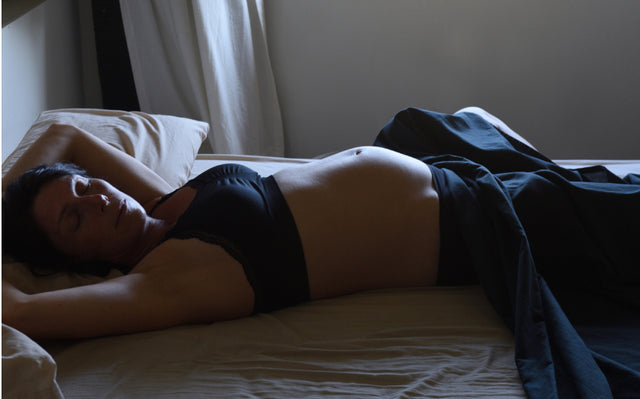Childbirth is one of the world’s most wondrous, joyful, natural phenomenaBut as anyone who’s done it can attest, it has its challenges. One can be the heavy bleeding that occurs shortly after giving birth. This is known as postpartum bleeding.
Curious to know why postpartum bleeding happens?hat’s normal when it comes to it, or where to find postpartum underwear to help? Read on as we unpack the postpartum bleeding stages and how to manage them.
Is vaginal bleeding normal after birth? Why does it happen?
Sure is, and it happens whether you give birth vaginally or via Caesarean section.
During your pregnancy, blood vessels connect your placenta to your uterus. When the placenta comes away from the uterine wall after your baby is born, those blood vessels are open and bleed. Your uterus contracts to squeeze them shut for up to 10 days, during whichthe bleeding should slowly lessen.
How much postpartum bleeding will there be?
The amount varies for each postpartum body, but it’s typically not like a normal period (unless yours is always super heavy).
During the first 2 days after birth, the bleeding is usually bright red and heavy – as much as the equivalent of one sanitary pad per hour. Over the next few days, the bleeding should slowly reduce and change colour from bright red to pink or brown before eventually lightening to a creamy discharge colour.
Bleeding is often heavier in the morning when you get up, after breastfeeding, or after exercising (if you’re up to doing that in the first 6 weeks – and hey, many of us aren’t). Many people aren’t ready for blood clots after birth, as they can be quite large.

What’s the deal with blood clots after birth?
For most people, postpartum bleeding will last up to 6 weeks after giving birth, but that’s not a given. Similarly, while for some, bleeding tapers nicely according to expectations, for others, it’s more of a stop/start affair, so when you think it’s over, it starts up again.
How long does postpartum bleeding last?
The postpartum bleeding stages are different for everyone. But for most people, it will last up to 6 weeks after giving birth. Similarly, while bleeding tapers nicely according to expectations for some, it can stop, then come back again for others.

What happens if the bleeding gets heavier – instead of lighter?
There are a few causes of increased bleeding in the postpartum period. One is if your uterus doesn’t contract properly to close off the blood vessels. Another is called retained placenta, which is when your placenta doesn’t come away in its entirety after birth, leaving some tissue still attached to the uterine wall, which prevents your uterus from contracting. If your vagina, cervix or uterus has been injured during birth, or you have an infection, you might also experience excessive bleeding in the postpartum stage.
How do you know if your uterus is contracting normally?
Your midwife will usually check this by feeling your belly for the location of your fundus (the top of your uterus). As the uterus contracts, it gets smaller and is felt lower in your abdomen, and by 10 days after birth, it should have contracted enough not to feel it when pushing on your abdomen. Ask your healthcare provider to show you if you’re concerned, or just curious.
When should you ask for your help?
If you’re worried or don’t feel right, don’t feel embarrassed or awkward about asking for help. Guidelines from Queensland Health advise calling your healthcare provider if, more than 24 hours after giving birth:
- You're still soaking the equivalent of more than one pad every 1-2 hours
- The amount of bleeding suddenly/drastically increases, or you pass larger clots
- Your bleeding changes from a pink/brown colour to a bright bed
- You feel dizzy, weak, sweaty, have a fever or have trouble breathing
- You pass blood which smells
Heather’s Story
I had retained placenta with my first 2 babies, which means I only passed parts of my placentas – they broke up – rather than coming out in a nice tidy piece, and this caused major bleeding, which was, unfortunately, ongoing.
With my first birth, I had a postpartum haemorrhage within hours of giving birth, so I was taken into the operating room for a ‘manual removal’ of my placenta which was stuck pretty hard and fast and not cooperating – or coming out the usual way.
After that, my bleeding continued pretty heavily and didn’t settle, but I figured it was normal (first time and all), so I just continued and lived on Sustagen to keep my energy levels and milk supply up as I was trying to breastfeed.
About 10 weeks after giving birth, I was unpacking the dishwasher, and I passed a clot out of the blue the size of a dinner plate. Horrified, I contacted my obstetrician and returned to the hospital for another D&C procedure. After that, the bleeding finally slowed andstopped, but it was a rocky intro to first-time parenthood.
With my second baby, I had the same retained placenta problemsI was more prepared this time, and I was kept in the delivery suite all day after giving birth with a midwife giving my belly a mighty push every hour to help expel any retained blood and placenta. Luckily I’m not squeamish.
Still in the hospital after a few days, my blood clots started getting much bigger and more frequent – rather than smaller and less often – and I was surprised when the nursing staff told me to catch them in a dustpan when I went to the bathroom so they could measure their size and work out my blood loss.
I can’t say carrying my clots down the hospital corridor in a dustpan in the middle of the night is one of the highlights of my parenting life so far.Still, it did help show that things weren’t normal, so, yep, you guessed it, another D&C was booked in, with a blood transfusion to help me recover and get my energy up more quickly.
By the time baby 3 came around, my obstetrician advised the hospital that my placenta wouldn’t be coming out of its own accord, so he just went ahead and manually removed it after the birth while my epidural was still in action and then did another sweep a few hours later. So, it wasn’t quite as easy breezy in reality as that sounds, and it hurt like hell the second time, but it worked, and I didn’t have to have a D&C or a blood transfusion.
I’m not sharing this to scare anyone, I’m sharing to highlight the fact that whatever you read or think you know, you just don’t know how things will go, so don’t be too set on the fact that your bleeding should last 6 weeks and expect that on the first day of week 7, you’ll be sporting a beige thong or hitting the beach, but you might. Just go with the flow (literally), but if your bleeding persists, gets heavier, or your clots get larger or more frequent (like mine), don’t suffer in silence.There's a reason, and the sooner you find out what it is, the sooner you can sort it out and get back to learning how to care for your new baby (and yourself).
Our Postpartum Underwear is here to help.
Modibodi reusable underwear has a built-in absorbent lining that absorbs postpartum bleeding, making it the perfect afterbirth underwear.
Our Maternity Brief in Maxi is one of our most popular styles of postpartum underwear. Featuring our most absorbent lining from the front to the back waistband and a V-shaped waistband to sit comfortably below your bump or post-baby belly.
Available in different styles to suit different bodies and sizes, it’s the best choice for postpartum underwear. We suggest you pack a few pairs into your hospital bag for those first few days to have a ready supply when needed.
As you progress naturally along the postpartum bleeding stages, you may want to switch to our Heavy-Overnight or Moderate-Heavy absorbencies. There’s a pair for every stage of your postpartum journey.






